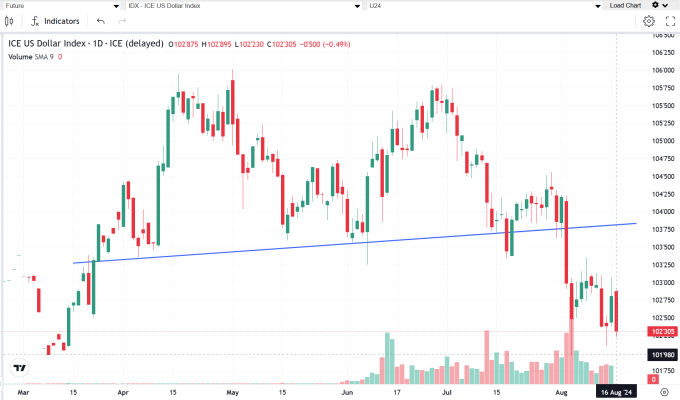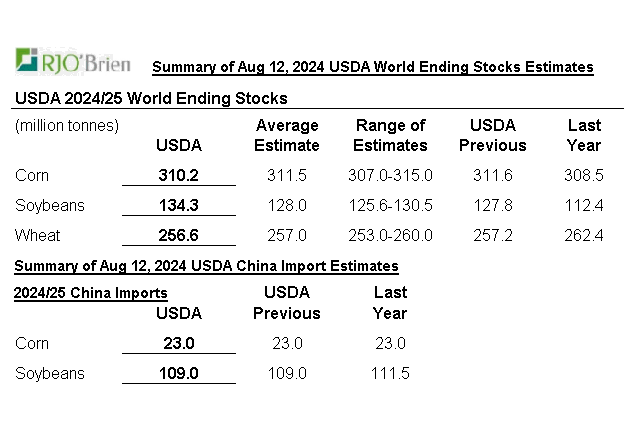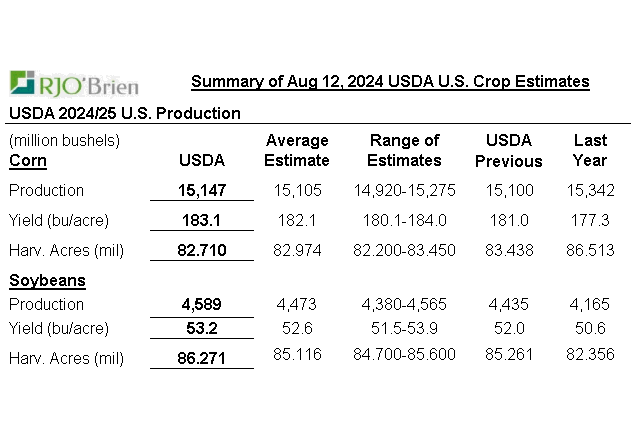Howdy market watchers!
The heat of August is upon us. The school year has begun and seems to start earlier every year. It is always a difficult transition from summer to the back-to-school routine. However, it also means football is coming soon as are cooler temperatures.
The thought of fall weather sounds both refreshing and yet unrealistic that it will ever return, again. Like many things these days, we must maintain hope. Expecting the unexpected is now the new norm and so let us maintain our composure amongst these extremes.
The University of Michigan Consumer Sentiment Index came in at 67.8 last month, marginally higher than expectations of 66.9 and was the first increase in five months. Inflation expectations came in at 2.9 percent, as expected, and in line with annual inflation rates released this week for July that were the lowest since March 2021. For the five-year period of inflation expectations, that number was 3 percent, but also in line with expectations.
Core CPI for July, excluding food and energy, increased 0.2 percent over the prior month and 3.2 percent annually, but in line with expectations. While on one hand this is welcome news that should lead to an interest rate cut in coming months, it also inevitably comes with a cooling business environment that can cast a shadow over consumer demand. The 0.4 percent increase in shelter costs, i.e., rent expense, accounted for 90 percent of this last month’s increase across all items. Energy was flat with weaker crude oil prices while food prices increased 0.2 percent despite continued weakness across primary grain commodities.
These stickier retail food prices are gaining the attention of the presidential candidates who are making bold election promises about lowering food costs. In various conversations this week, it is more apparent than ever that consumers and businesses are feeling the pinch of higher costs in nearly all segments of supplies and services and of course, interest rates. The data says the consumer is still strong-ish, but ask the person next to you and you may find a very different feeling about the strength of our consumer driven economy.
There is broad based uncertainty across the economy that is about to get even more ‘weird’ as the presidential election heats up. The mud slinging has only just started and will soon get muddier. Presidential platforms are getting defined and the funding race is underway.
What a week it has been in the markets! After a near capsizing over the past two weeks, cooler heads prevailed and buying returned. Equity markets have rebounded strongly from 3-month lows that came about in just 3-days to start the month of August. The Dow and S&P dipped to their 200-day moving averages before finding support and the NASDAQ pierced the 200-day vail, but not for long.
Needless to say, it has spooked a lot of small money traders in the markets. Metals markets have seen similar action, touching down on their 200-day moving averages before finding stability. Energy has whipsawed violently balancing weaker global demand with the threat of escalation in the Middle East, which was expected to escalate this past week only to moderate. However, stay vigilant as the time is likely coming.
The tone across agriculture commodities has seemed to only be mono-directional: selling. Monday’s USDA WASDE, Row Crop and Wheat Production reports was cause for fresh, new volatility that the markets seemed to have a difficult time interpreting. While numbers were somewhat supportive for wheat and corn, these markets managed to still make new lows in Friday’s trade. Now, they did bounce off the lows before the close, but still ended the week with a new low. Frustrating to say the least.
As I’ve pinpointed recently, the main thing we need is demand generally, but export demand specifically. In fact, demand continues to pick up, but the large money, net shorts just don’t seem to be overly bothered. The US dollar has been weakening as forecasts of interest rate cuts increase and have aided US competitiveness. China is back in the market, but not aggressively. They have had some large purchases recently and did announce increased soybean imports last week, but still in line with the “needed” pace for USDA forecasts and so this is expected business rather than extra business. Nonetheless, it is “needed” business to keep the balance sheets in check.

China, however, has a lot of new crop purchases to catch up on. The expected low in corn and soybeans is then likely put in when China starts buying US new crop aggressively. While we are all thinking and hoping that could be soon, it has yet to transpire.

The ProFarmer Midwest Crop Tour starts next week, which will provide another perspective on corn and soybean yields, but through field inspections. Traders will be watching if variability in flooded areas and the extremities of the belt are large enough areas to at all threaten trendline yields.
On Monday, the USDA increased US corn yields to 183.1 bushels per acre (bpa) above the 181.0 bpa previously and last year’s 177.3 bpa. That would be a new average yield and phenomenal in all respects. This increased production above trade guesses, but perhaps more importantly, harvested acres were lower than last month’s guesses and versus expectations.

Demand also increased and the combination resulted in lower ending stocks in the marketing year ahead. So, despite headline bears, there is reason to think that demand could stabilize the corn market here. Admittedly, the December new crop corn has really been trying to stay above $4.00 and while it closed below it to end the week, could be back at or above it soon. We need to see this soon for hope that we’re not going to a lower level.

Harvest has started in the southern plains, but it hasn’t started in the areas that really matter and more news of record yields if demand news is quiet could see further softness. The same goes for soybeans that have an even less compelling story. NOPA crush for July released Thursday showed some demand firmness with slightly higher than expected crush and lower than expected oil stocks.
The saving grace for soybeans could be the developing dryness in Brazil. In fact, Bloomberg just published an article this past week highlighting that barge operators there are saying that the Amazon is under a worse drought than last year. Soybean traders will be watching this development closely to find an area for buying to return to the oilseed complex.
The International Grains Council this week raised global corn and soybean production forecasts, but cut wheat production.

Egypt’s major tender announcement to purchase wheat through April fell well short of the volume expectations this week, siting financing complications for not following through with a large, private deal after only a small, public deal was announced.
The biggest news in the wheat market are increasing reductions in the French and German wheat crops. Estimates came out this week that Germany’s wheat crop is likely to be reduced by 13 percent from last year due to wet weather at harvest causing delays and quality issues. France has been in the news over the past few weeks on wheat quality concerns that were partially mitigated this week, but quality still remains variable and volumes are well below recent years and still expected to be the smallest crop since the 1980s.
The cattle market has also suffered from extreme whipsaw in recent weeks, but managed to stabilize for most of this week before another selloff Friday. Feeder and Live cattle contracts closed up off the lows in Friday’s session, but lower than I would have liked to see.
The cause? Well, equities were firmer, grains were weaker and the fundamentals remain bullish. There was likely some profit taking in play being the end of the week after a decent rebound from the lows and looming concerns over consumer strength. Cash markets have only dropped about one-third of the move in future’s contracts that is a strong sign of buying optimism, but the futures are still the primary base of risk management and so makes protection difficult in this environment.
The good news is that the cash markets remain strong throughout the cattle complex. Small calves, feeder steers and heifers, culled cows, bulls continue to bring eye-opening values. Let’s hope market uncertainty until the election doesn’t overly impact consumer demand to buy beef as we should be able to maintain continued strength in the coming years as herd rebuilding has yet, if only is just getting started. The reality is that short-term movements in futures contracts do not have to reflect long-term fundamentals.
My opinion is to protect your physical on rallies to profitable levels in hopes that you don’t have to use the insurance, meaning the market price is higher than your breakeven. I would not own cattle, especially if you’re buying (stockers) at these levels, and not protect them. Bred heifers and cows are a different story. The issue with owning anything short-term is that when they need to go, you are a price taker. Cattle have limited flexibility in terms of when they need to move. Protect the downside when you own them and after you sell them, we can always purchase a call option to cover you on the upside if you believe they sold cheaper than they should have.
Sidwell Strategies is the one-stop shop to protect cattle with futures, puts, LRP or a combination of all, which is probably the best strategy overall. If you’re ready to trade commodity markets, give me a call at (580) 232-2272 or stop by my office to get your account set up and discuss risk management and marketing solutions to pursue your objectives. Self-trading accounts are also available. It is never too late to start and there is no operation too small to get a risk management and marketing plan in place.
Wishing everyone a successful trading week! Let us know if you'd like to join our daily market price and commentary text messages to stay informed!
Brady Sidwell is a Series 3 Licensed Commodity Futures Broker and Principal of Sidwell Strategies. He can be reached at (580) 232-2272 or at brady@sidwellstrategies.com. Futures and Options trading involves the risk of loss and may not be suitable for all investors. Review full disclaimer at http://www.sidwellstrategies.com/disclaimer.
On the date of publication, Brady Sidwell did not have (either directly or indirectly) positions in any of the securities mentioned in this article. All information and data in this article is solely for informational purposes. For more information please view the Disclosure Policy here.
Disclaimer: The copyright of this article belongs to the original author. Reposting this article is solely for the purpose of information dissemination and does not constitute any investment advice. If there is any infringement, please contact us immediately. We will make corrections or deletions as necessary. Thank you.







